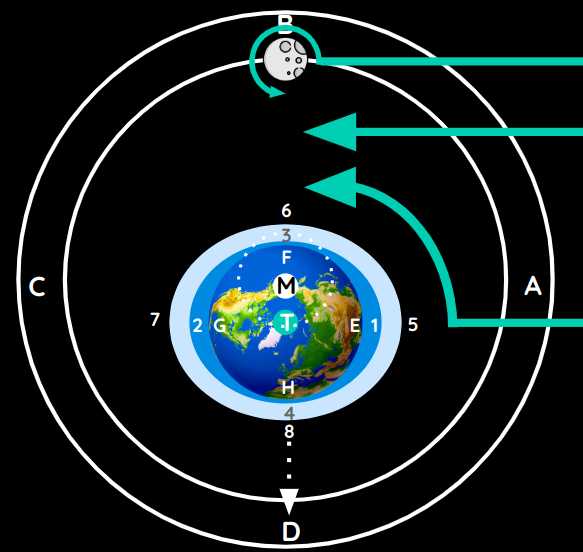The Tides and the Moon
Table of Contents
50. Why does water rise at the 6 1/5 hour and descend at the 6 1/5 hour?
The part of the Earth at F will be at point G after 6 hours.
- After 6 hours more, it will be at
H

The Moon also moves somewhat from B towards C, covering the circle ABCD in 1 month.
The part of the Earth that is now in F is opposite the Moon’s body.
- After 6 hours and 2 minutes, it will be beyond point
Gin that diameter of the vortexABCDwhich intersects the same diameter in which the Moon will then be, and the water will be highest there. - After 6 more hours with 12 minutes, it will be beyond point
H, where the water will be least high, and so on.
This is why the sea water should ebb and flow every 12 hours and 2 minutes in the same location.
51. Why tides are greater when the Moon is full or new.
This vortex ABCD is not precisely circular.
Its diameter, in which the Moon revolves when it is new or full, is shorter than the one that intersects it at right angles, as shown in the upper part.
Consequently, the tides should be greater when the Moon is new or full than in the intermediate times.
52. Why are the Tides Greatest at the Equinoxes?
The Moon is always near the plane of the Ecliptic, while the Earth, with its diurnal motion, rotates in the plane of the equator.

These 2 planes intersect at the equinoxes but deviate significantly from each other at the solstices.
Consequently, the greatest tides should occur around the beginning of spring and autumn.
53. Why air and water always flow from East to West
As the Earth moves from E through F towards G, or from the west to the east, the bulge of water 4 1 2 and the bulge of air 8 5 6, which now press on the Earth’s part E, gradually migrate to other, more westerly parts of it.
Thus, after 6 hours, they press on the Earth’s part H.
After 12 hours, on the Earth’s part G.
The same applies to the bulges of water and air 2 3 4 and 6 7 8. Therefore, water and air continuously flow from the eastern parts of the Earth to its western parts.
54. Why, at the same latitude, regions with a sea to the east are milder than others
This flow is not very swift. This is clearly detected from long voyages being much slower and more difficult towards the east than towards the west.
Also, in certain narrow seas, water always flows westward.
Moreover, in regions with a sea to the east, such as Brazil, they do not feel as much heat from the Sun as those with long land stretches to the east and a sea to the west, such as Guinea.
This is because the air coming from the sea is cooler than that from the land.
55. Why there is no ebb or flow in lakes and ponds, why it occurs at various times on various shores
The oceans should be thought of as totally enveloping the entire Earth.
Lakes and ponds have waters separated from the ocean.
They do not experience such motions because their surfaces are not wide enough to be pressed more on one side than the other due to the Moon’s presence.
The ocean is surrounded by the inequality of sinuosities and windings.
- This makes the changes in its water reach different shores at different times.
56. How the specific causes of these variations should be investigated on individual shores.
The particular causes of all these variations can be deduced from the foregoing if we consider that
When the Moon is new or full the ocean waters are:
- highest in places far from the shores towards the Ecliptic and the Equator at both the sixth morning and evening hours
- most depressed at the 12th hour, flowing back from the shores to those places.
The water is carried to the shores faster or slower, and in a greater or lesser volume depending on whether:
- the shores are near or far
- the waters go to those shores through more direct or oblique, wide or narrow, deep or shallow paths
Due to the very diverse and unequal windings, the waters tending towards one shore often meet those coming from another shore.
- This causes their course to change in various ways.
Finally, various winds, some of which are regular in certain places, impel these waters in different ways.